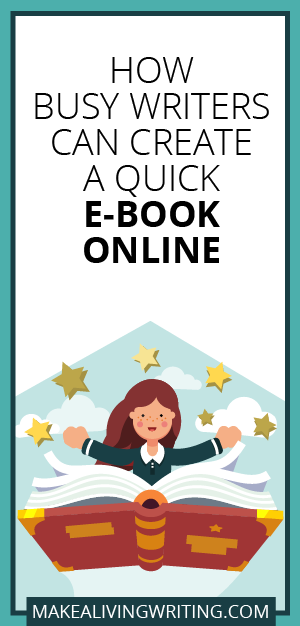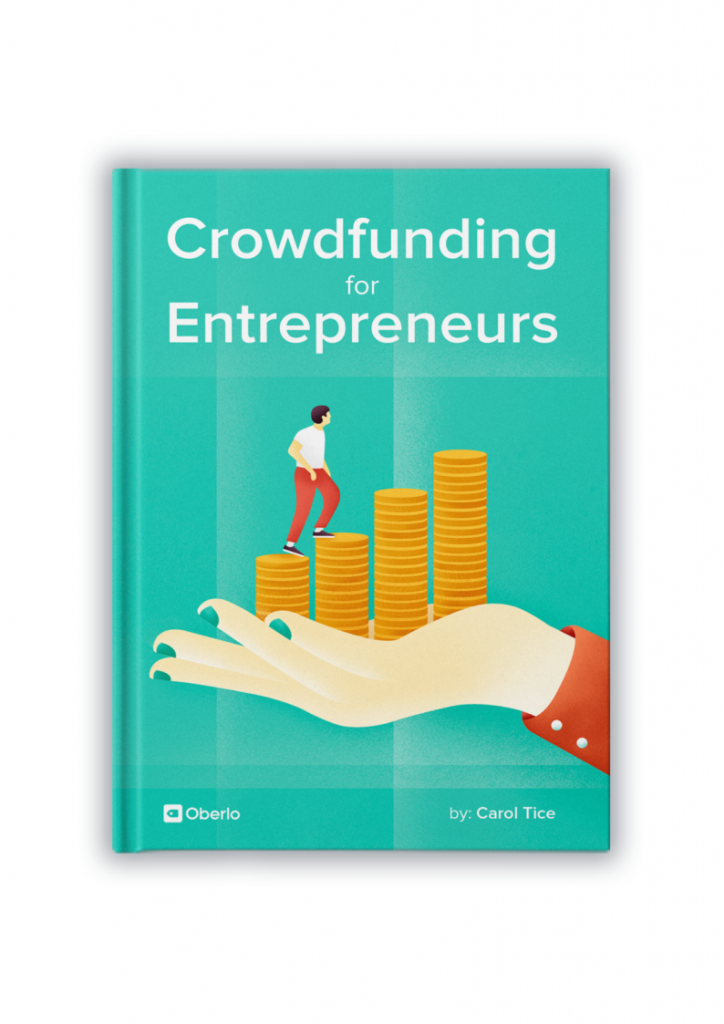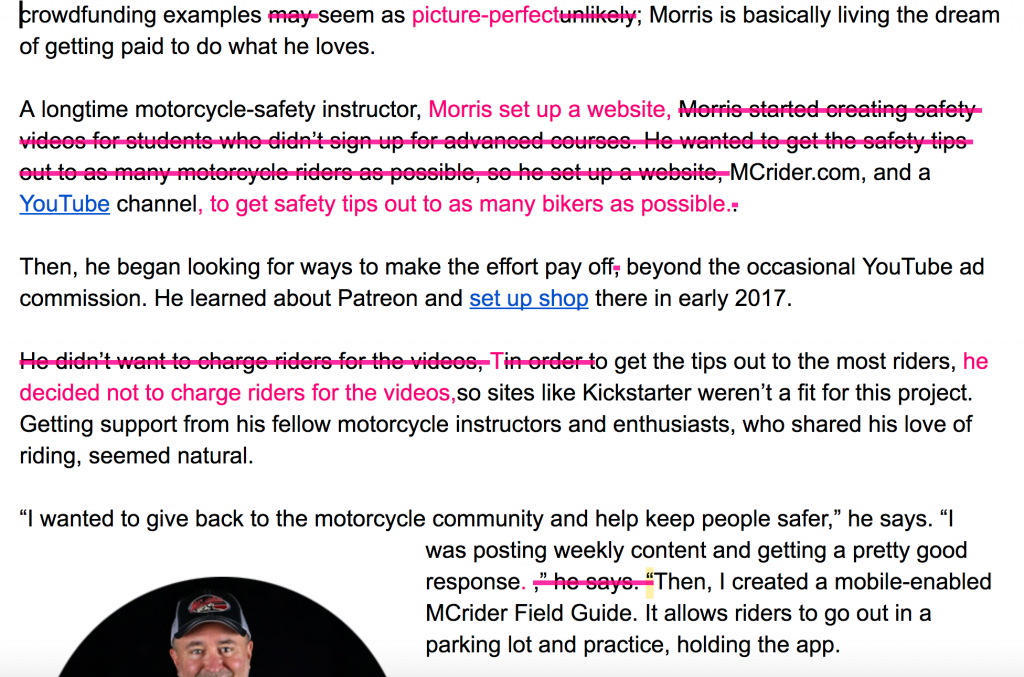 It was the middle of a too-hot summer, and I was already booked to the gills. Then, I got an offer — from a NYSE-traded, major corporation — to write my ideal project: a 20,000-word e-book. Right now. For a high four-figure fee. If you’ve ever wondered how to write an e-book fast, when you’re already busy… that was my challenge.
It was the middle of a too-hot summer, and I was already booked to the gills. Then, I got an offer — from a NYSE-traded, major corporation — to write my ideal project: a 20,000-word e-book. Right now. For a high four-figure fee. If you’ve ever wondered how to write an e-book fast, when you’re already busy… that was my challenge.
I took the writing job, and learned some new productivity tricks along the way. In this post, I unpack them for you.
My first big tip is to remember one of my Newtonian laws of freelancing: Work expands to fill all available space.
 When you take on more work, you naturally find ways to be more efficient. You stop goofing around and get serious. So, don’t be scared to take on more! You’ve got this.
When you take on more work, you naturally find ways to be more efficient. You stop goofing around and get serious. So, don’t be scared to take on more! You’ve got this.
The more you do, the more you can do. So if you get more work, don’t freak out.
That said, I had to get creative to fit 20K extra well-researched words into my already busy schedule, to meet this e-book deadline.
And I did it — my e-book Crowdfunding for Entrepreneurs is out now, yay!
How did I do it? Here are the productivity steps I took:
Keep the engine running
The #1 thing you have to do in this situation is commit to positive self-care. Gotta make sure you eat healthy, get enough sleep, and exercise. Also, reach out and get support from your writer community. None of that can stop.
If you chain yourself to the desk, you’ll soon be exhausted and unable to write anything worth a darn. Writing will go s l o w e r. So that’s no good.
I also did not stop taking my Sabbath off, if you’re wondering. A full day off is totally key for maintaining productivity.
I did end up with days where I started work at 6:30 am and ended at 10 pm, with only time off for meal breaks and a quick dog walk or swim. But there were no round-the-clock marathons, no missed meals or all-nighters.
The result was that I didn’t burn out. I was able to keep chugging for about 7 weeks, until the e-book was done.
Get on a page
The biggest way to save time on a big project is to write from an approved outline. My e-book editor and I spent several days going back and forth, refining our chapter outline and the key subheads within each chapter.
With a strong outline in hand, I knew how much space I had for each subtopic. I wrote to length and didn’t have to cut a lot later. I also didn’t have the nightmare of turning in work my editor didn’t expect or like — it was all mapped out in the outline.
Slow stuff first
When you’ve gotta meet a short, word-heavy deadline, the first thing to prioritize is: whatever takes longest.
I began by reaching out for all of the interviews I needed. For every chapter. Gathering all the interviews and research info up front meant I found out quickly if key sources wouldn’t be available, so I could locate alternates and stay on deadline.
I ended up with a nice pile of interviews early on, which meant the final weeks were free for quickly writing the last few chapters. Speaking of which…
How to write an e-book? One chapter at a time
I used this trick writing both of my print books, too. Once your chapter outline is nailed, pick a chapter and don’t think about anything else ’til it’s done.
This seriously helps avoid freakouts. I didn’t wake up in the morning and go “Holy hell, I need to write 15,000 more words, right quick!”
Instead, I woke up and thought, “Right now, I’m writing a 4,000-word chapter on the Top 20 crowdfunding platforms. That’s all I have to worry about today.”
Seriously, put on the horse blinders and block out your project’s massive size. Focus in on the current section of the project. Complete it. Then, move on.
As in The Phantom Tollbooth, you don’t want to hear your task is impossible until after you’ve accomplished it.
Write what you want
You don’t have to write a 100-page e-book in order, from page 1 through to 100. Personally, I like to get rid of the hard stuff first!
In this e-book, that was the Top 20 crowdfunding websites list — tons of research and interview work went into it. So I wrote that one early on, and left simpler chapters for later.
You should also write whatever tickles your interest. If chapter 3 is next, but your head is buzzing with ideas for chapter 4, write that one! You’re in charge of how you get this done.
Compact your process
Now I will reveal what an anal-retentive, systematic writer I am on big, reported pieces. I usually have a many-step process to write a draft. It goes like this:
- Print out all the notes.
- Re-read all my interviews, to get the materials fresh in my mind again.
- Highlight all the best parts.
- Create an outline of the best stuff I have from each source.
- Carefully pull from outline as I write, making sure I use everything important.
With this e-book writing project, it quickly became clear I wouldn’t have time to do all that with the FIFTY pages of notes I’d compiled. So I came up with a shorter process.
Here’s what I did instead:
- Don’t print anything.
- Read each interview through one time, without highlighting.
- As I read, I typed quotes and facts straight into the e-book draft where needed.
- Never looked at the notes again.
This process was a revelation. I usually worry that I’ll be missing some key item if I don’t highlight and outline notes. Now, that’s over! Doing the once-through process in future.
Keep going and leave blanks
The corollary to the no-outline process above, is to not move back-and-forth constantly from writing to shuffling through notes looking for factoids. Just write!
If you come to a point where you’d need to hunt for a quote or fact, just leave a blank. As in:
Smith said, “QUOTE GOES HERE.”
Keep writing. At the end of the day, or the chapter, go shuffle through your notes and find the missing bits.
Batch the trivia
Creating an e-book today involves a lot of moving parts. I needed to source and correctly size dozens of images, for instance. Also needed to learn how to create GIFs and make about 8-10 of them.
Since I hate technology, I waited for a time when I was feeling rested and ready to tackle learning the new tools. Then, I made most of the GIFs in one sitting.
Doing these tasks in batches helped me stay on track. Take the task of placing needed screenshots into the draft where they belonged: I just labeled all images well, tossed them all in a folder, and then placed them into the draft when it was complete. Boom!
Don’t obsess on SEO
Using keywords is important (despite what you may have heard) in all online writing. It’s also key not to think about keywords all the time, while you’re trying to write. This will interrupt your creative flow.
This was my keyword-insertion process:
- Take a look at keywords for the chapter.
- Start writing. Use keywords as it makes sense and naturally occurs.
- Review final draft and insert more keywords as needed.
Thinking about keywords sentence-by-sentence will make you nuts. Speaking of which…when you’re freaking out about a big deadline, remember that you don’t have to do it all yourself.
Be a project manager
These days, e-book construction has many moving parts. My e-book required:
- Writing
- Keyword work to optimize for search engines (SEO)
- Screenshots
- Headshots
- GIFs & videos
- Editing
- Marketing
When the deadline is tight, it’s smart to outsource some of these tasks. I hired an editor and got a photo editor to correctly size and layout images. I also had my social media manager (a/k/a my oldest son) prep all the needed social media posts.
My editor gave me the option of self-editing the draft, but frankly it was all a blur. I felt it needed outside eyes — and that I wouldn’t have time. So I hired an editor (and editing teacher), Susannah Noel, to review my work.
In the final crunch, Susannah brought fresh eyes and great suggestions, 90% of which my assigning editor and I loved. I spent $750 of my fee on this, and feel it was worth every dime. Now, I know my e-book isn’t some sloppy, slapped together, unintelligible garbage!
Here’s a sample of how many changes my draft needed:

On the photo side, as you can see a bit of above, all the head shots of people quoted had to be put in a vexing circular format this company prefers. Like I’m figuring that out!
My blog-post image designer Mark Ellis took on the e-book images. The result looked way more consistent than I’m sure I could have produced, even if I had all year. Which I didn’t.
Honestly, it took a village.
Don’t look back
Do you write and rewrite the first few paragraphs of long pieces, and then have to write later parts in a huge rush, because you’re out of time? That used to be me. But with a long e-book, that habit has to go.
No obsessing!
I resisted the urge to compulsively rewrite the opening of the first chapter, while neglecting other tasks. Instead, I created a very rough draft of the opening, and moved on. Then, at the end, I circled back to quickly tweak it into shape.
Communicate
The final piece of this puzzle is keeping your editor informed, so there are no surprises. My outline and our planned keywords underwent some needed changes as I wrote — and I always alerted my editor right away.
The result was a no-surprises first draft that quickly won approval. Avoiding the sea-of-red-ink response is a top way to make big writing projects efficient.
Learn to write e-books
To sum up: I loved doing this project! I enjoy going in-depth on a topic. Now, I have a nice, recent portfolio sample for my chosen niche of writing and ghostwriting books and e-books.
If you want to earn more, I highly recommend learning to write longer projects such as e-books. Getting a 4-figure check definitely beats writing for $50 or $100 a blog post.
How do you quickly write big projects? Let’s discuss on Facebook or LinkedIn.
The post How to Write an E-Book Fast — When You’re Already Overbooked appeared first on Make A Living Writing.
from Make A Living Writing https://ift.tt/2Ecv25c

No comments:
Post a Comment